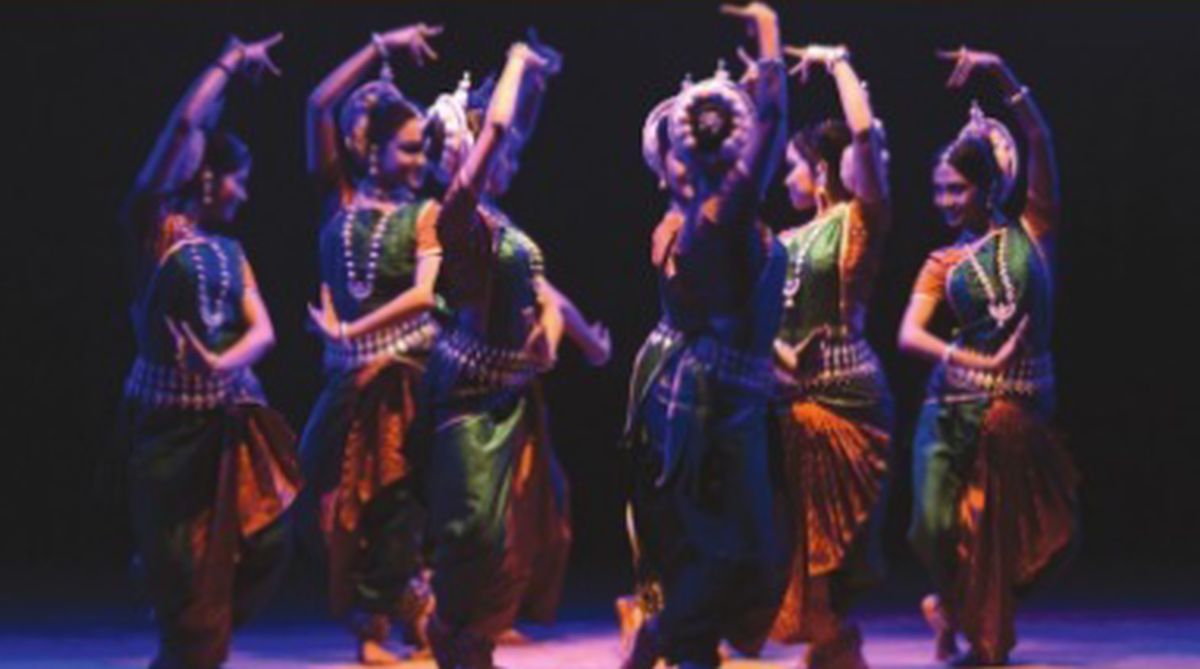Adhering To Tradition
A dance festival organised by Shinjan Nrityalaya focused on gods and goddesses as the central theme.
The two-day Guru Kelucharan Mohapatra Award Festival showcased impeccably rich performances.
Tapati Chowdhurie | September 15, 2018 4:38 am

Dancers perform Mati.
When it comes to Indian performing arts, the 20th century was a happy one in many respects. Legends such as Uday Shankar, Guru Gopinath and Rukmini Devi Arundale, among others, were born and they gave new direction to our classical traditions.
Born on 8 January 1926 in Odisha’s Raghurajpur, Guru Kelucharan Mohapatra was one such personality. He resurrected the ancient Odissi dance form and was one of the foremost choreographers of all times. He fused movements with musical tempos to the highest degree of sophistication, which were comparable to choreographic works of the very best in the world. He is a name to reckon with and Srjan, the institution he started, draws people from across the world to this day.
Advertisement
An annual award festival, which started during the lifetime of the guru, is still held. In 2018, the Guru Kelucharan Mohapatra Award Festival celebrated its 24th edition.
Advertisement
On the opening day of the festival, Rajashree Praharaj’s solo presentation at Rabindra Mandap in Bhubaneswar set the tone. She paid her obeisance to Lord Jagannath. The skillfully presented Hamsadhwani Pallavi, choreographed by Guru Kelucharan Mohapatra and composed by Bhubaneswar Misra, was a good choice to establish herself, before she went on to the abhinaya piece, Sita Haran(The Abduction of Sita).
The petite performer did well in the shoes of Rama, the protagonist; Sita his consort; Lakshmana, the caring brother; Ravana, the fierce abductor and Jatayu, the loyal bird, all at once. Groomed to perfection both in the technical aspects as well as the dramatised portions by her mentor and Guru Ratikant Mohapatra, who accompanied her on the mardala, she was a performer par excellence that evening. The musical group consisted of the talented duo, Suromoni Ramesh Chandra Das and Agnimitra Behera on the violin; Srinibas Satpathy’s lilting flute music with the melodious singing of Rupak Kumar Parida.
On the concluding day, Ratikant Mohapatra awarded artistes of national and international repute. This year, the festival presented the NALCO Guru Kelucharan Mohapatra Award to Sachi Das for his contribution to theatre and dramatics and Lingaraj Behera for his immense contribution to Odissi dance. Additionally, the NALCO Guru Kelucharan Mohapatra Yuva Prativa Samman was presented to four meritorious young artistes in the area of classical dances and Odissi music for their continuous outstanding performances.
They were Sonali Mohapatra (Bhubaneswar) and Subikash Mukherjee (Kolkata) for Odissi dance, Swati Sinha (New Delhi) for Kathak and Rohan Suresh Dahale (Mumbai) for Odissi music. A book called Dancing into Eternity, an endearing view of the multi-faceted life and works of Guru Kelucharan Mohapatra, published by Ratikanta Mohapatra, director, Srjan, was released on the auspicious concluding evening.
Soon after giving away the awards, the new age choreographer of excellence, Guru Ratikanta Mohapatra presented his repertory members to the audience with his new work, Kirwani Madhurima, a neo-classical Odissi dance presentation, scripted by Pandit Nityananda Misra in his Sanskrit translation from the original Telugu music composition of Vyzarsu Balasubramaniam.
It was an experimental work combining classical and contemporary music, introducing new movements without compromising on the style —starting from the costumes to the jewellery, dance steps, use of improvised karana stances that come naturally to Odissi. Movements were simple, easy to negotiate and hold audience attention at the same time. The whole piece had a ballet like structure, polished to shine and provide a visual extravaganza.
The group of slender dancers then presented a special performance, Mati, derived from an inspiring and popular poem by the iconic Odia poet Radha Mohan Gadanayak. The dance choreography was done by Ratikant Mohapatra. The music composition was by Laxmikant Palit and the script adaptation was by Jaydev Das. Dancers Rajashree Praharaj, Ritu Sengupta, Pragna Parimita Das, Riyanka Chakrabarty, Aishwariya Singhdev, Sipra Swain, Maya Krishnamurty, Preetisha Mohapatra and Reebdhita Barua presented this exemplary composition with great energy and synchronisation.
The storyline, though quite didactic, was given a contemporary interpretation. Mati or Earth is personified to the position of an elevated and emancipated soul, with no desire, ready to don the mantle, the Almighty bestowed upon her with a smiling face. Drama and pure dance were inseparably inter-woven. Movements rehearsed to the hilt were sharp and knife edged, moving in unison with simple and improvised steps. There were not too many circular hand movements as is usual with Odissi.
The story gargled, murmured, crossed boulders, meandering, manoeuvring and negotiating in its progression through difficult and not-so-difficult cuts and bends in the likeness of a river, personifying the five elements. It was innovative and well designed by the master choreographer, Ratikanta Mohapatra. The audience left the hall hankering for more.
Advertisement
A dance festival organised by Shinjan Nrityalaya focused on gods and goddesses as the central theme.
City dwellers were enthralled by the creative dance drama that was aesthetically executed at a soiree recently.
It was a happy collection of dancers that had gathered to showcase the timelessness of Guru Kelucharan Mohapatra’s choreographic works.…
Advertisement
